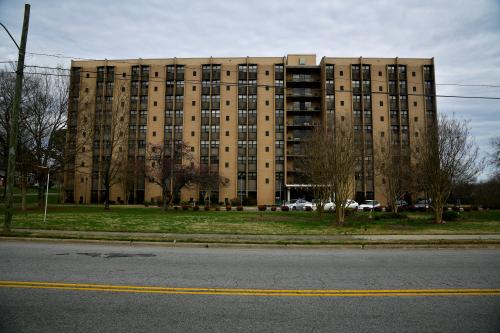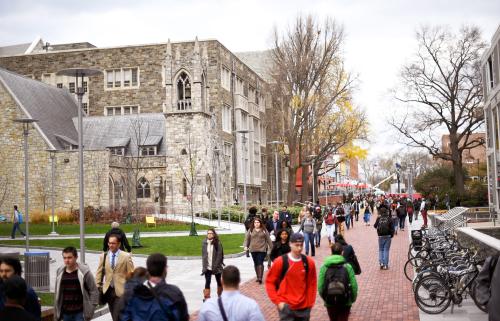If you want more content like this, subscribe to our newsletter.
This week in Class Notes:
-
- Fear of Ebola was a powerful force in shaping the 2014 midterm elections.
- Increases in the “sticker price” of a college discourage students from applying, even when they would be eligible for financial aid.
- The gender gap in housing returns is large and can explain 30% of the gender gap in wealth accumulation at retirement.
- Our top chart shows how social distancing can benefit the economy.
- Gianpaolo Baiocchi and H. Jacob Carlson present the argument for a rent moratorium.
- Finally, check out my piece with Johnathan Rothwell on how the poor face double the risks during the COVID-19 pandemic.
The virus of fear: The political impact of Ebola in the US
What is the effect of fear on the political behavior of voters? Do individuals actually change their behavior as a result of fear, or is fear simply correlated with ideological views that ultimately guide behavior? To help answer these questions, Campante et al. exploit a natural experiment that affected individuals’ threat perceptions – the Ebola scare, which hit the United States a month before the 2014 midterm elections. The authors find that Ebola concerns caused a decrease in the Democratic vote share in that year’s midterm elections, along with lower turnout, though this was not related to a general or Obama-specific anti-incumbent sentiment. Additionally, Republican candidates, especially those facing competitive races, exploited the episode in their campaign strategy, by emphasizing the topic in conjunction with themes such as immigration, terrorism, and anti-Obama rhetoric. Survey evidence suggests that voters responded with increasingly conservative attitudes on immigration but not on other ideologically-charged issues, implying that the impact of the threat in changing voters’ minds was dependent on easily-drawn connections between the threat and specific issues.
Do college applicants respond to changes in sticker prices even when they don’t matter?
A college’s “sticker price” and the actual costs students pay can differ significantly for students who receive financial aid. However, a lack of understanding of college pricing and the financial aid system may cause students not to apply to some colleges because of perceived high cost. In this paper, Levine et al. test for this “sticker shock” using College Board data on SAT scores sends to state flagship institutions for students entering college in 2006–2013. The authors’ results indicate that “sticker shock” is indeed an issue that affects application decisions of potential college students who would be eligible for financial aid. Overall, students are sensitive to changes in sticker prices in the application stage of the process. A 10% increase in sticker prices at a public flagship generates around a 1.2 to 1.8 percentage point reduction in the likelihood of applying to an institution, as proxied by sending SAT scores. Additionally, price increases at public flagships are found to reduce enrollment of high achieving students, regardless of financial aid status, who often choose private colleges instead.
The gender gap in housing returns
Housing wealth represents the dominant form of savings for American households. In this study, Goldsmith-Pinkham et al. investigate how men and women differ in their financial returns to housing investments. Using detailed data on housing transactions across the United States since 1991, the authors find that single men earn 1.5 percentage points higher unlevered returns per year on housing relative to single women. Approximately half of this gap can explained by the choice of where and when to buy, and when to sell; women tend to buy in locations when aggregate house prices are high and sell when they are low. However, a large gender gap persists even after accounting for these differences. Among men and women who buy and sell in the same zip code and year-month, women still earn 0.8 percentage points lower unlevered annualized returns. This gap grows significantly after accounting for mortgage borrowing: men earn 7.9 percentage points higher levered returns per year relative to women. This is due to differences in execution prices: women buy the same property for approximately 2% more and sell for 2% less. Women experience worse prices at the point of purchase and sale because of gender differences in the negotiated discount relative to the list price. Overall, the gender gap in housing returns is economically large and can explain 30% of the gender gap in wealth accumulation at retirement.
Top chart
This week’s top chart shows that American cities that experienced the highest number of deaths from the 1918 Spanish flu pandemic also tended to suffer the biggest hits to their economies, as measured by the decline in manufacturing output and employment. However, the fatality rate was highly dependent on public policies. Cities that imposed tougher-than-average restrictions suffered 560 deaths per 100,000 people, on average, compared with 730 per 100,000 elsewhere. Furthermore, governments that implemented stricter policies, including banning public gatherings and shutting down churches and schools, fared better than those that adopted more lenient ones.

Choice opinion
“A rent moratorium would be a direct and rapid infusion of resources to the households where they are needed the most. We favor a universal program without requiring proof of tenants’ having been directly affected by the coronavirus: ‘Means testing’ during a crisis, and when the numbers are so high, risks missing many people in need and introduces unnecessary bureaucracy and costs. A rent moratorium should be thought of as a bailout for the most vulnerable…Congress has the responsibility to step in to stabilize both communities and the housing market. A rent moratorium is no substitute for a more rational and humane long-term housing policy, but Washington must take action now to protect families during this crisis,” writes Gianpaolo Baiocchi and H. Jacob Carlson in the New York Times.
Self-promotion
The COVID-19 pandemic is deepening the consequences of inequality. Individuals in low-wage, service-sector jobs are in a far more economically-precarious position than those working salaried jobs they can do remotely. However, the class gaps underscored by the pandemic go far beyond job security. In my new piece with Johnathan Rothwell “Class and COVID: How the less affluent face double risks”, I explore the wide gaps by income in the risks posed by virus – due to preexisting conditions – and the degree of response to risk of infection, including stocking up on food and working remotely.







Commentary
Class Notes: College ‘sticker prices,’ the gender gap in housing returns, and more
Wednesday, April 8, 2020